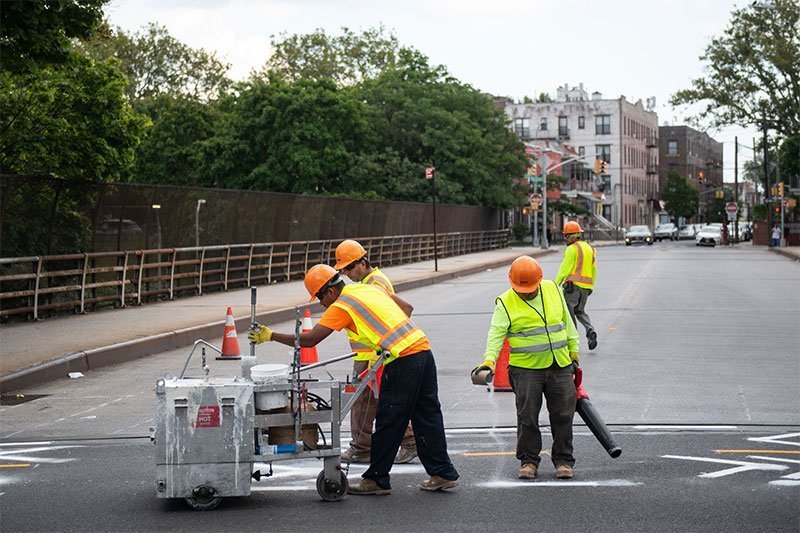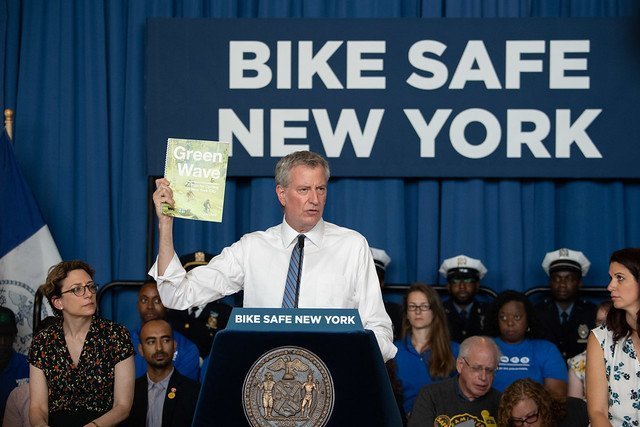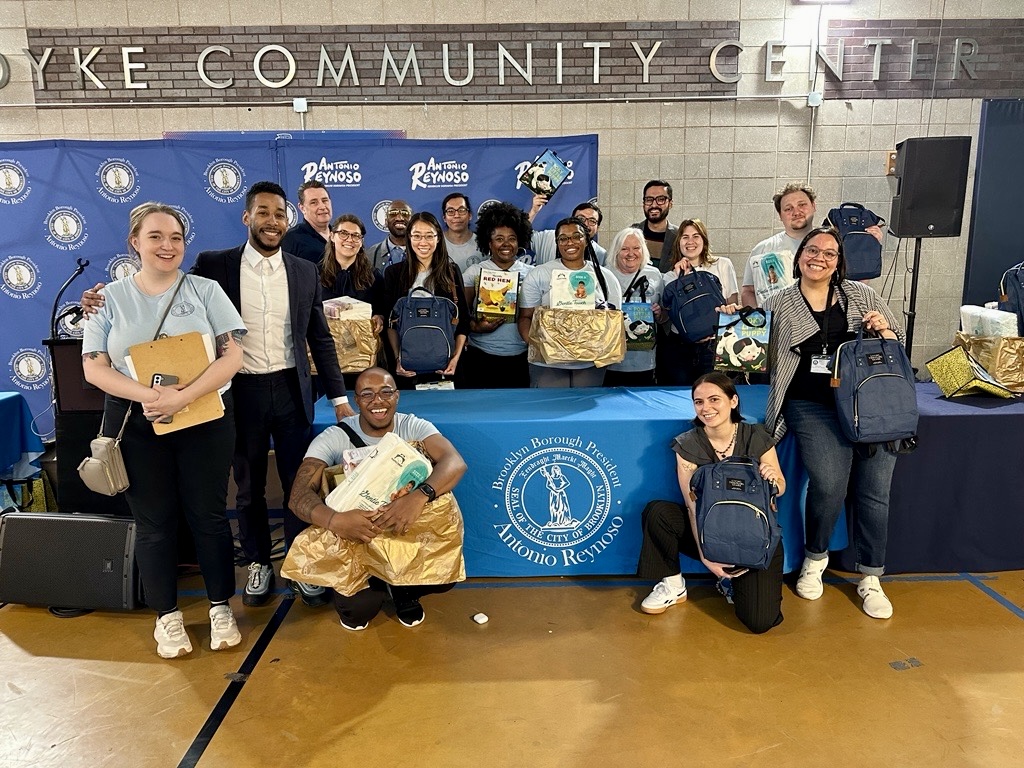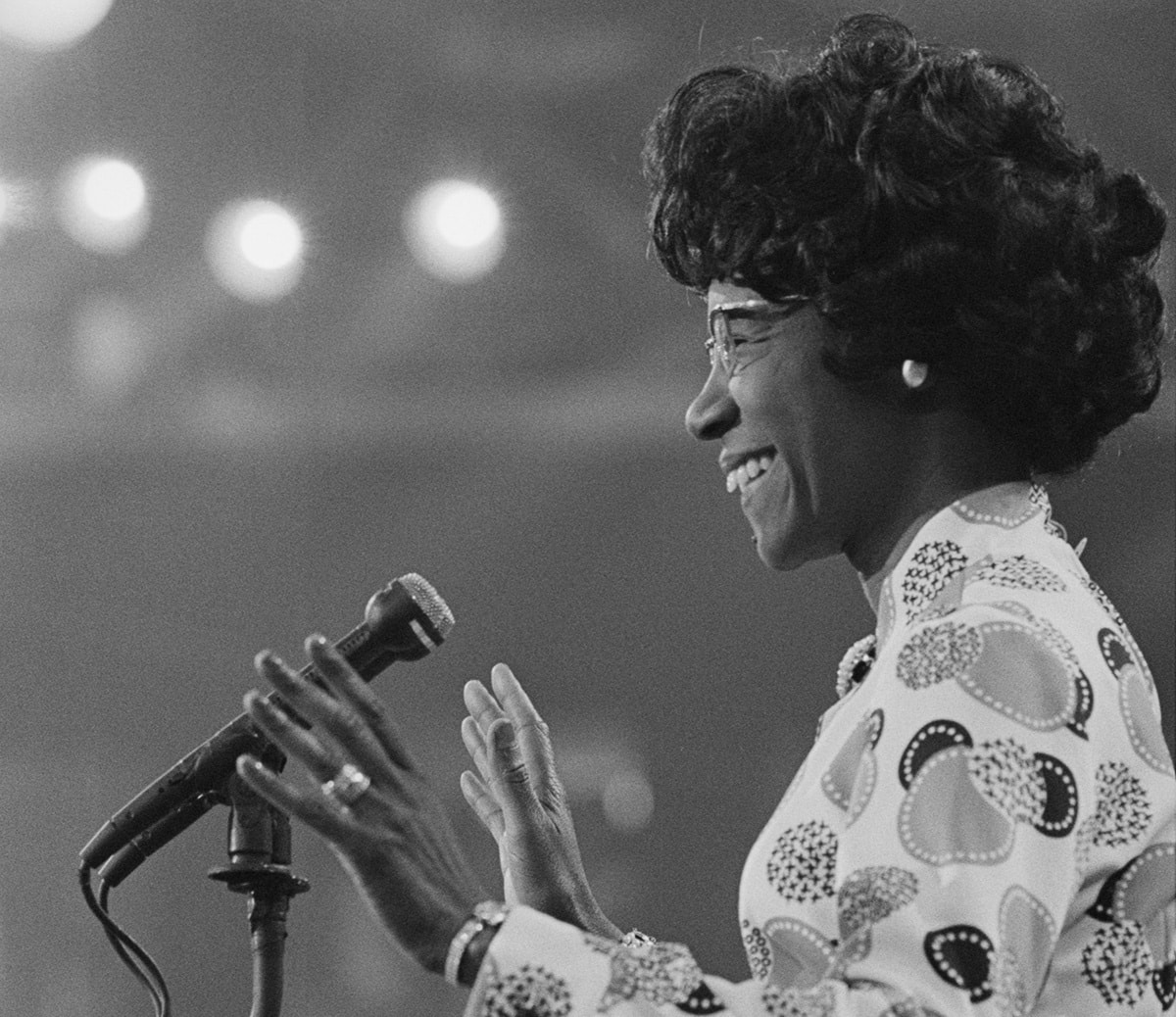Several Brooklyn lawmakers hailed Mayor Bill de Blasio release of his “Green Wave: A Plan for Cycling in New York City” today to confront the rise in cycling fatalities in 2019.
As cycling continues to grow dramatically, the $58.4 million plan combines design, enforcement, legislation, policy and education to make the City’s streets safer for cyclists — and all street users.
With fatalities heavily concentrated this year in Brooklyn, the Mayor unveiled the plan in Bay Ridge, a neighborhood that this year will receive its first on-street protected lanes along 7th Avenue.
“When we came into office we promised New Yorkers we’d do everything we could to end traffic fatalities,” said de Blasio. “No loss of life on our streets is acceptable. With a dangerous surge in cyclist fatalities, we have to keep pushing the envelope and increasing our efforts. That’s what this plan is about. It’s a continuation of our promise. This time, specifically to bikers. We are here to protect you and we take that job seriously. We will not stop until we have finally reached Vision Zero.”

The seventeen bicyclist fatalities so far this year represent the highest number through July of any year since the launch of Vision Zero in 2014, after a record-low 10 fatalities in all of 2018. This year, 12 (or 71%) of this year’s cyclist fatalities have been in Brooklyn, and eight fatalities involved cyclist interactions with trucks.
The Green Wave Plan is a multi-prong, multi-agency approach to curtail bike injuries and fatalities at a time when cycling popularity is on the rise, the city continues to expand its bike network and Citi Bike is expanding into new neighborhoods and boroughs.
According to DOT’s Cycling in the City report 24% of adult New Yorkers ride a bike, with a half-million cycling trips made on a typical day. Citi Bike, the nation’s largest bike-share system continues to grow and recently announced plans to double its footprint and triple its fleet by 2023. In the past three years the City has added an average of 62 bike lane miles per year, including over 20 protected bike lane miles.
The new plan includes the following major elements:
Create Citywide Protected Bike Lane Vision
- To implement the Green Wave plan, the City has committed $58.4 million in new funding over the next five years, with 80 additional new staff.
- Build 30 miles of protected bicycle lane annually, guided by a PBL vision document. By the end of 2021, DOT will install over 80 miles of protected lanes. These projects are currently in various stages of planning and design.
- DOT has identified 10 Brooklyn and Queens community boards as Bike Priority Districts, which together represent 16% of community boards and 14% of the bike lane network – yet have 23% percent of all NYC’s bicycle fatalities. DOT has committed to build 75 miles of bicycle infrastructure in these districts by 2022.
- Spur increase in cycling mode share for safety and emissions reduction, furthering OneNYC 2050 goal that 1 out of every 10 trips in NYC be taken by bicycle.
Improve and Update Design
- DOT will build upon innovative intersection designs with a focus on areas where the majority of fatalities occur.
- Fifty (50) intersections will receive turn calming treatments in 2019 and where possible, protected intersection designs will be added for new projects after streets are resurfaced or reconstructed.
- Among innovations, DOT will in 2019 pilot so-called “Green Wave,” progressive signal-timing that discourages speeding and encourages steady cycling speeds — and it will identify other corridors for implementation in 2020.
- Install Green Skip Bars at key intersections to increase cyclist visibility.
Expand NYPD Enforcement
- Under the plan, the NYPD will ramp up enforcement at the 100 most crash-prone intersections and target enforcement on highest risk activities: speeding, failing to yield, blocking bike lanes, oversized trucks/trucks off route.
- Maintain continuous citywide implementation of “Operation Bicycle Safe Passage” initiative – extending elevated enforcement of blocked bike lanes and hazardous driving violations. Since implementation of Operation Bicycle Safe Passage, NYPD has doubled enforcement of cars parked in bicycle lanes and issued more than 8,600 summons in the first three weeks of July.
- Specialized units and precincts will increase enforcement against oversized and off-route trucks.
- The NYPD also announced that supervisors would respond to collision sites to determine if the right-of-way laws should be applied — and that it would also discontinue its practice of ticketing cyclists at the site of fatal cyclist crashes.
- NYPD supports new and emerging technology for automated enforcement.


“I am very pleased to learn that the Mayor’s Office is taking significant action to make our streets safer for cyclists. 2019 has already been a deadlier year for cyclists in New York City than the entirety of 2018. Most of these incidents have occurred in Brooklyn, and too many have sadly occurred within my District. Brooklynites deserve much better. I hope that this plan will put an end to cycling fatalities and help to make our streets safe for all,” said U.S. Rep. Yvette Clarke (D-Central Brooklyn).
“In my district, we have neighborhoods that are both underserved by public transit and left out of investments in alternative transportation,” State Sen. Zellnor Y. Myrie said. “Meanwhile, enforcement of traffic safety laws has too often targeted communities of color and cyclists rather than wreckless truckers and drivers. I commend the mayor for taking a step toward making New York’s streets safe for all New Yorkers and creating true transportation equity.”


“More than a dozen cyclists have been killed by vehicles this year alone on our streets, including some who were struck while biking in broad daylight in our own district. I’m hopeful that the mayor’s plan to eliminate these fatalities will succeed, but it needs to be carried out as swiftly as possible in order to avoid yet another cyclist’s preventable death. For even one more person to die because of our city’s lack of adequately protected bike lanes is completely unacceptable. We need to do better, and I look forward to working with the mayor’s office to make Vision Zero a reality,” said State Sen. Julia Salazar.
“I am appreciative of City Hall’s redoubling of its street safety efforts, especially in light of the terrible tragedies that have been occurring to cyclists and pedestrians on Brooklyn’s streets. It is long past time we get serious about building out a truly connected network of safe bike infrastructure, including a focus on priority corridors in underserved communities like Bay Ridge, Brownsville, Midwood, and Sheepshead Bay. We need equitable attention paid to intersection redesigns and enforcement of our traffic rules. I am eager for fast-tracking implementation and for addressing this Vision Zero crisis with the sense of urgency it demands,” said Brooklyn Borough President Eric Adams.

















